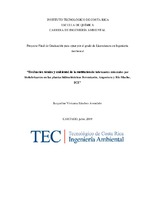Mostrar el registro sencillo del ítem
Evaluación técnica y ambiental de la sustitución de lubricantes minerales por biolubricantes en las plantas hidroeléctricas Reventazón, Angostura y Río Macho, ICE
| dc.contributor.advisor | Roldán-Villalobos, Carlos | es |
| dc.contributor.author | Sánchez-Avendaño, Jacqueline Vivianna | |
| dc.date.accessioned | 2019-10-02T21:47:14Z | |
| dc.date.available | 2019-10-02T21:47:14Z | |
| dc.date.issued | 2019 | |
| dc.identifier.uri | https://hdl.handle.net/2238/10872 | |
| dc.description | Proyecto Final de Graduación (Licenciatura en Ingeniería Ambiental) Instituto Tecnológico de Costa Rica, Escuela de Química, 2019. | es |
| dc.description.abstract | In production of hydroelectric energy is used lubricants for the operation of the generating units and the hydraulic equipment of the dam. These lubricants are petroleum derived (mineral origin), therefore they release important CO2 emissions, contributing with the increase of greenhause gases, among other environmental problems. For this reason, there is interest in the substitution of this type of lubricants for biolubricants obtained from oleaginous seeds of plants, such as rapeseed. To determine the environmental impact of the proposed substitution, the lubricants and biolubricants were evaluated separately through a life cycle analysis that allowed the identification of the emissions derived from the production, use and disposal. The current biolubricant market was reviewed to analyze the available options. After the study of the physicochemical properties of the available lubricants and biolubricants, structural afinity was determined and thus, the biolubricants offered in the market are able to comply with the lubrication task. Thereby, the biolubricants could be used in the operation of the existing equipment in hydroelectric plants. Taking into consideration the life cycle of both products, it was determined that the lubricants emit 3,93 kg CO2 eq/l lubricant, while the biolubricants produce 1,06 kg CO2 eq/l lubricant, so the use of biolubricants implies a reduction of 2,87 kg CO2 eq/l lubricant. Hence, it was concluded that the biolubricants are more environmentally friendly. Through the finantial evaluation it was dilucidated that the usage of biolubricants represents a major cost when buying the product, nevertheless, the environmental benefits exceed the costs. Then, it is concluded that the project is recommended from a technical, environmental and financial perspective. | es |
| dc.description.abstract | En la generación de energía hidroeléctrica se utilizan lubricantes para la operación de las unidades generadoras y de los equipos hidráulicos de la presa. Los lubricantes son de origen mineral (derivados del petróleo) y liberan importantes emisiones de CO2, contribuyendo al aumento de los gases de efecto invernadero, entre otros problemas ambientales. Es por esta razón que hay interés en sustituir este tipo de lubricantes por biolubricantes, que se obtienen a partir de semillas oleaginosas de plantas, como la colza. Para determinar el impacto económico y ambiental de realizar la sustitución propuesta, se analizaron los impactos ambientales de los lubricantes y biolubricantes por separado realizando un análisis de ciclo de vida de ambos productos para evaluar las emisiones de CO2 eq que se derivan de la producción, uso y disposición. Se revisó el mercado actual de los biolubricantes para analizar las opciones disponibles y después de estudiar las propiedades fisicoquímicas de los lubricantes y los biolubricantes disponibles se determinó que son estructuralmente afines, por lo que los biolubricantes ofrecidos por el mercado están en capacidad de cumplir bien la tarea de lubricación, por lo que es posible utilizarlos en la operación de los equipos existentes en las plantas hidroeléctricas. Tomando en consideración el ciclo de vida de ambos productos, se determinó que mientras los lubricantes emiten 3,93 kg CO2 eq/l lubricante, los biolubricantes producen 1,06 kg CO2 eq/l lubricante, es decir, al usar biolubricantes se logran reducir 2,87 kg CO2 eq/l lubricante, por lo que se concluyó que los biolubricantes son más amigables con el ambiente. La evaluación financiera permitió determinar que la utilización de biolubricantes representa un costo mayor a la hora de comprar el producto, pero los beneficios ambientales superan los costos, por lo que el proyecto es recomendable desde la perspectiva técnica, ambiental y financiera. | es |
| dc.language.iso | spa | es |
| dc.publisher | Instituto Tecnológico de Costa Rica | es |
| dc.rights | acceso abierto | es |
| dc.subject | Equipo | es |
| dc.subject | Petróleo | es |
| dc.subject | Efecto invernadero | es |
| dc.subject | Gases de invernadero | es |
| dc.subject | Hydroelectric power | es |
| dc.subject | Petroleum | es |
| dc.subject | Research Subject Categories::NATURAL SCIENCES::Chemistry | es |
| dc.subject | Lubricantes | es |
| dc.subject | Planta hidroeléctrica | es |
| dc.subject | Energía hidroeléctrica | es |
| dc.subject | Hydropower plant | es |
| dc.subject | Lubricants | es |
| dc.subject | Greenhouse gases | es |
| dc.subject | Greenhouse effect | es |
| dc.title | Evaluación técnica y ambiental de la sustitución de lubricantes minerales por biolubricantes en las plantas hidroeléctricas Reventazón, Angostura y Río Macho, ICE | es |
| dc.type | proyecto fin de carrera | es |


